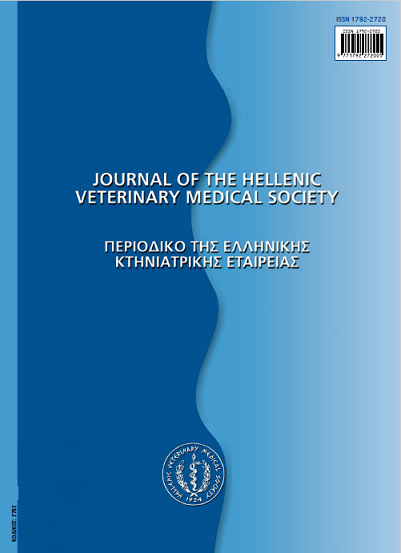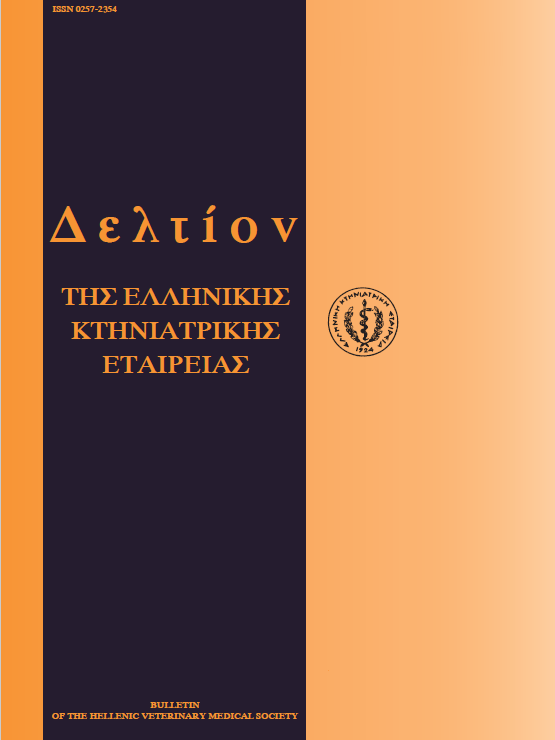Βελτίωση της μακροβιότητας του κατεψυγμένου σπέρματος του επιβήτορα

Περίληψη
Η οξειδωτική καταπόνηση των σπερματοζωαρίων κατά τη διάρκεια της συντήρησης του σπέρματος σε χαμηλές θερμοκρασίες έχει αποδειχθεί ότι είναι υπεύθυνη, σε ένα ποσοστό, για τη μείωση της κινητικότητας και της γονιμοποιητικής τους ικανότητας. Η παρούσα εργασία πραγματοποιήθηκε με σκοπό την εκτίμηση της in-vitro επίδρασης των αντιοξειδωτικών, της καφείνης ή του συνδυασμού τους στη μακροβιότητα του κατεψυγμένου σπέρματος του επιβήτορα. Ίσα μέρη κλάσματος εκσπερματίσματος απαλλαγμένου από τη ζελατινώδη φάση (η=12), τα οποία συλλέχθηκαν από 5 ίππους Αραβικής φυλής (9-18 ετών), μη γνωστής αντοχής των σπερματοζωαρίων στην κατάψυξη, αναμείχθηκαν σε αναλογία 1:1 με αραιωτικό Tris-κρόκου αυγού. Έγινε φυγοκέντρηση σε 500 χ g για 5 min, απομακρύνθηκε το υπερκείμενο υγρό και στο ίζημα των σπερματοζωαρίων γινόταν προσθήκη σε 2 φάσεις αραιωτικού, το οποίο περιείχε ή δεν περιείχε αντιοξειδωτικά (0.50 mg/ml πυρουβικό νάτριο, 1 mg/ml θειοθειϊκό νάτριο, 5 mg/ml αλβουμίνη βοείου ορού, 0.15 mg/ml χλωριούχο ψευδάργυρο και 0.50mg/ml 3-υδροξυ-4-μεθοξυ-κυναμικό οξυ).Στη συνέχεια, το αραιωμένο σπέρμα καταψύχθηκε με τη μορφή συμπυκνωμένων σφαιριδίων των 0.25 ml. Πριν την κατάψυξη, η τελική συγκέντρωση της γλυκερίνης, καθώς και ο αριθμός των σπερματοζωαρίων ήταν 5% και 562-924x106/ml, αντιστοίχως. Τα κατεψυγμένα σφαιρίδια αραιωμένου σπέρματος, με ή χωρίς αντιοξειδωτικά, αποψύχθηκαν σε διάλυμα Tris-κιτρικό οξυ-γλυκόζη(40°C για 30 sec), το οποίο περιείχε 0, 0.49, 0.97 ή 1.94mg καφείνης/ml και επωάσθηκαν (ΐ40-230χ106 σπερματοζωάρια/ml) σε θερμοκρασία 30°C για 3 h. Η κινητικότητα των προοδευτικά κινουμένων σπερματοζωαρίων (%) εκτιμήθηκε μετά τη φυγοκέντρηση, πριν την κατάψυξη και 0, 1, 2 και 3 h μετά την απόψυξη. Τα αποτελέσματα έδειξαν ότι υπήρχε σημαντική επίδραση (Ρ<0.05)των χειρισμών στην κινητικότητα των σπερματοζωαρίων μόνο μετά την απόψυξη. Η προσθήκη μόνο αντιοξειδωτικών ή μόνο καφείνης δεν βελτίωσε σημαντικά τη διατήρηση της κινητικότητας του σπέρματος. Αντίθετα, η προσθήκη των αντιοξειδωτικών, σε συνδυασμό με 0.97 ή 1.94 mg καφείνης/ml, αποτέλεσαν τον καλύτερο συνδυασμό για τη σημαντική βελτίωση της μακροβιότητας των σπερματοζωαρίων του επιβήτορα.
Λεπτομέρειες άρθρου
- Πώς να δημιουργήσετε Αναφορές
-
KCHALIFA, T., WAHEED, M. M., & LYMBEROPOULOS (Α.Γ. ΛΥΜΠΕΡΟΠΟΥΛΟΣ) A. G. (2017). Βελτίωση της μακροβιότητας του κατεψυγμένου σπέρματος του επιβήτορα. Περιοδικό της Ελληνικής Κτηνιατρικής Εταιρείας, 57(3), 195–204. https://doi.org/10.12681/jhvms.15039
- Τεύχος
- Τόμ. 57 Αρ. 3 (2006)
- Ενότητα
- Research Articles
Οι συγγραφείς των άρθρων που δημοσιεύονται στο περιοδικό διατηρούν τα δικαιώματα πνευματικής ιδιοκτησίας επί των άρθρων τους, δίνοντας στο περιοδικό το δικαίωμα της πρώτης δημοσίευσης.
Άρθρα που δημοσιεύονται στο περιοδικό διατίθενται με άδεια Creative Commons 4.0 Non Commercial και σύμφωνα με την άδεια μπορούν να χρησιμοποιούνται ελεύθερα, με αναφορά στο/στη συγγραφέα και στην πρώτη δημοσίευση για μη κερδοσκοπικούς σκοπούς.
Οι συγγραφείς μπορούν να καταθέσουν το άρθρο σε ιδρυματικό ή άλλο αποθετήριο ή/και να το δημοσιεύσουν σε άλλη έκδοση, με υποχρεωτική την αναφορά πρώτης δημοσίευσης στο J Hellenic Vet Med Soc
Οι συγγραφείς ενθαρρύνονται να καταθέσουν σε αποθετήριο ή να δημοσιεύσουν την εργασία τους στο διαδίκτυο πριν ή κατά τη διαδικασία υποβολής και αξιολόγησής της.




